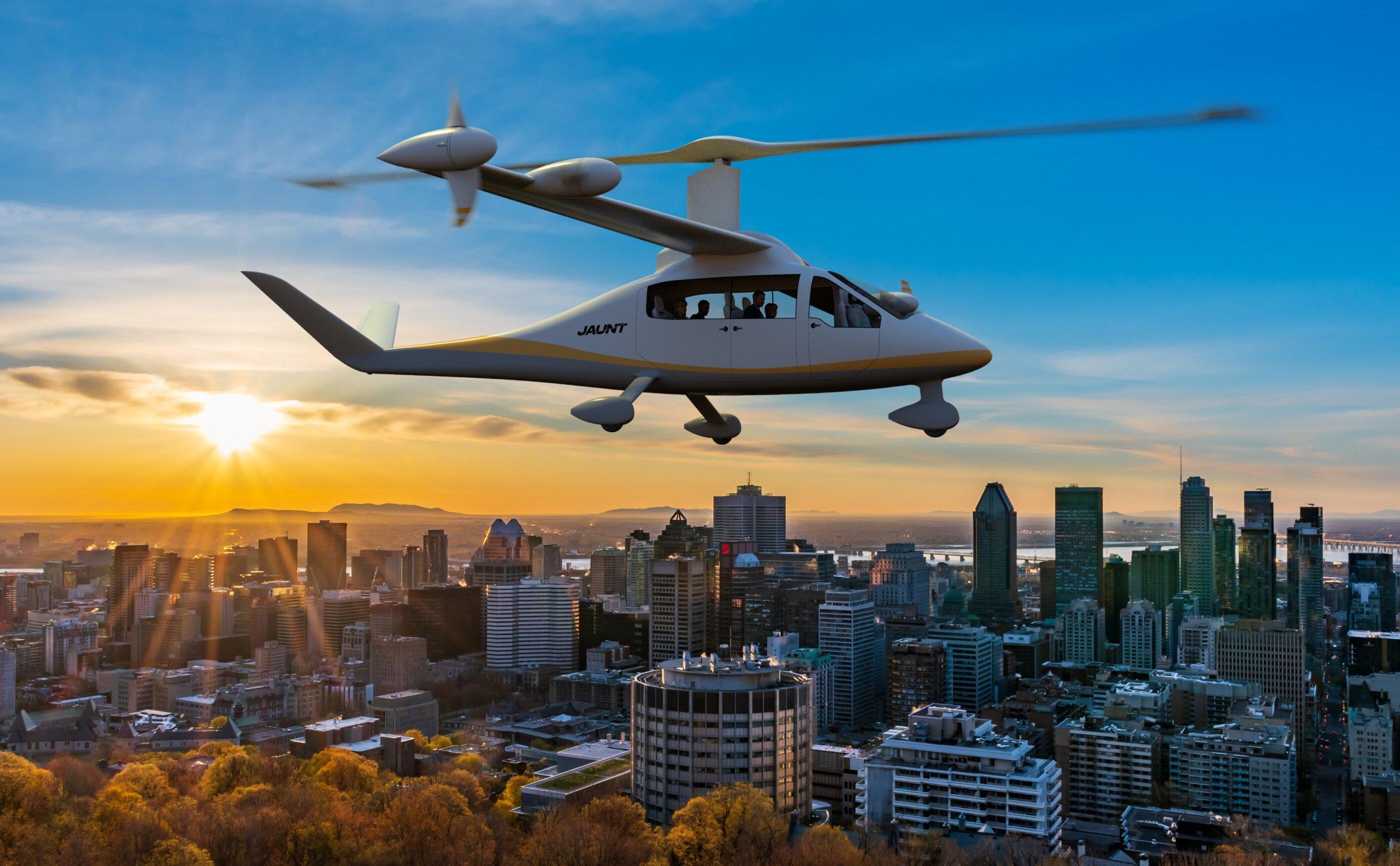
The Jaunt Journey’s large main rotor is partially-powered in horizontal flight.
Credit: Jaunt Air Mobility
Jaunt Air Mobility has confirmed plans to sell its quarter-scale air taxi technology demonstrator as a standalone product, which will be offered alongside its full-size Journey electric-vertical-takeoff-and-landing (eVTOL) vehicle.
The subscale prototype was originally envisioned as an uncrewed demonstrator to prove out the technologies of Jaunt’s unique electric slowed rotor compound design. But after customers expressed interest in the unmanned prototype as a standalone product, the company figured it could market it as a drone for applications including cargo, logistics and surveillance, according to Jaunt President Eric Cote.
“Honestly, the main goal of the smaller version was never to commercialize it. It was to increase the speed of our full-size program by validating the technologies,” Cote tells the AAM Report. “But now we see an opportunity to offer something that can be a unique solution for the drone market, in addition to the full-sized aircraft.
“A lot of technologies we are developing on this smaller version will be up scalable to the full-sized aircraft because they are fundamentally the same exact configuration,” he adds. “We see it as something that will be great for beyond-visual-line-of-sight [BVLOS] flying, particularly for missions related to cargo or logistics, because in many ways it is more capable than what other drones are offering.”
The subscale aircraft is also a possible contender to be flown in the planned research and development corridor established between the city of Joliette in Quebec and the Atikamekw First Nation of Manawan, part of a joint initiative announced with Quebec-based infrastructure startup Vertiko Mobility.
In addition to serving as a proving ground for advanced air mobility (AAM) technologies, the initiative will enable the transport of essential goods, including medicines, to the remote community , which is usually only reachable by high-operating-cost helicopter services. The total distance of the corridor is about 150 km (93 mi.), although Cote says Jaunt plans to operate 40-70 km legs initially.
Jaunt is headquartered in Dallas, although most of its design, engineering and manufacturing is based in Quebec.
Both the drone and five-seater air taxi share a unique slow-rotor-compound design, which resembles a helicopter with a large main rotor. But instead of a pusher propeller for horizontal flight, it has a fixed-wing with four propellers on the leading edge. The large main rotor is powered during takeoff and landing, and only partially powered during horizontal flight. The proprietary Slowed Rotor Compound (SRC) compound allows the tip speed of the rotor to match the aircraft's forward flight, creating almost zero drag, and allowing the Journey to fly efficiently like a plane.
Cote identifies three advantages behind the slowed rotor compound design, which the company has been refining since it bought the intellectual property behind the CarterCopter from Carter Aviation in 2019.
The number one advantage, he says, is that it consumes far less power than a tilting-propeller system, requiring just around 175 Wh/kg of battery power, or roughly the same amount found in an electric vehicle (EV) battery. By comparison, air taxis from Archer and Joby Aviation with tilting propellers are targeting between 250 and 350 Wh/kg.
The second major benefit is enhanced safety, Cote says, observing that FAA Part 29 certification rules for transport category rotorcraft require a design assurance level of ten-to-the-minus-nine, while Part 21.17b powered-lift rules are more flexible.
“In case we lose full power on every motor, we can still safely land the aircraft using autorotation. It doesn’t matter if we’re at 5 meters or 1,000 meters; we can safely maneuver to the ground and land pretty much anywhere,” he says. “We don’t need to have a ballistic parachute, which would add more weight and reduce the payload.”
The third major advantage is noise, he says. It is much quieter than a conventional helicopter because of the electric propulsion and lack of a pusher propeller. “Around 20% of helicopter noise comes from the tail rotor, and it can be the source of many accidents,” Cote adds. “For us, there is nothing in between the main motor and the tail of the aircraft, so it’s a really simple mechanical design.”
While the first-generation Journey is being marketed as an all-electric aircraft, Jaunt also has a partnership with advanced propulsion startup VerdeGo to explore a future hybrid-electric variant, which would significantly enhance the vehicle’s range from around 80 mi. (130 km) in its baseline configuration.
Jaunt is in the process of using learnings from its subscale demonstrator to build a full-scale Journey prototype, which it now expects to fly in 2025. Certification is expected by 2028.





